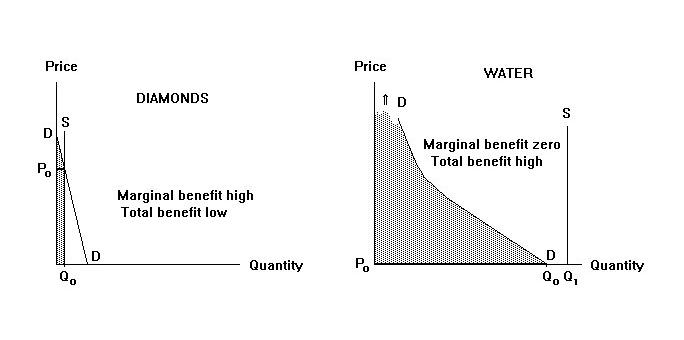
1. price is equal to marginal value, not total value.
2. price and value are two different things.
3. both of the above.
4. none of the above.
Choose the option that yields the correct answer.
The correct answer is option 1 . The consumer will purchase each commodity to the point where the marginal benefit to her is just equal to its price---price therefore equates with marginal value. It follows that if the supply of a commodity is very large relative to the demand, as is the case with water, its price and the marginal valuation of it by consumers will be very low. In the case of diamonds, the supply is very small in relation to the demand so the price, and the marginal valuation, is high. When we say that water is essential to life and diamonds are not we mean that the total benefit from water, given by the area under the demand curve to the left of the quantity consumed is very large, while the corresponding area under the demand curve for diamonds is small.
Water is portrayed as a free good in the right panel of the Figure below.

The quantity demanded of water at a zero price is less than the available supply. Since water is essential to life, it is reasonable to believe that the total area under this demand curve is very large---most of us, facing dehydration and death, would spend our entire income to obtain a first unit of water. Diamonds, in the left panel are in short supply relative to the demand for them, so their price is positive (most people think high). Our lives would continue if the entire world stock of them were to disappear, though we would be worse off by the shaded area under the demand curve in the left panel. Because diamonds are not essential to life, it is reasonable to believe that the shaded area on the diamonds diagram is smaller than the shaded area on the water diagram.
Option 2 is a poor choice because price and marginal value are indeed the same, though price and total value are not. It should be noted that, although we assume a perfectly inelastic supply of diamonds at the quantity Q0 , when we talk about the area under the demand curve for diamonds we are imagining the quantity of diamonds Q0 is freely available. Our supply curves in the Figure rule out cost-of-production issues that are not of interest here but will be the subject of the next topic.